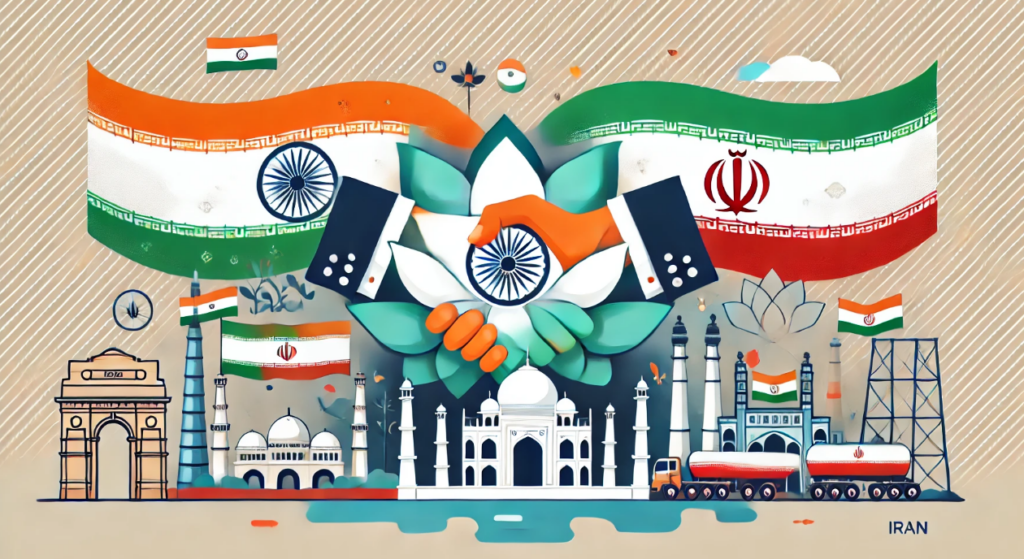The relationship between India and Iran holds immense geopolitical significance, rooted in millennia of shared history, culture, and trade. In the modern era, this partnership has evolved into a strategic relationship, underpinned by energy, infrastructure, and regional security cooperation.
Amidst growing challenges from the China-Pakistan nexus, India’s ties with Iran are increasingly seen as a linchpin for countering regional threats and enhancing India’s geopolitical position. This article explores the historical timeline of India-Iran relations, their current trajectory, and the potential for future collaboration to address common challenges.
Historical Timeline of India-Iran Relation
Ancient and Medieval Periods
- Cultural Exchange: India and Iran have shared cultural, linguistic, and religious exchanges for over 2,500 years. Zoroastrianism, brought to India by Persian migrants, became an integral part of India’s cultural fabric.
- Trade and Commerce: The Silk Road and maritime routes facilitated robust trade in spices, textiles, and precious metals.
Colonial and Pre-Independence Era
- British Interference: Under British colonial rule, India’s trade ties with Iran were constrained but not severed, as the two nations maintained cultural and personal exchanges.
Post-Independence Period (1947–1980s)
- Initial Diplomatic Engagement: Following independence in 1947, India established diplomatic relations with Iran in 1950. Despite ideological differences during the Cold War, economic and cultural ties persisted.
- Non-Aligned Movement (NAM): Both nations supported the NAM, advocating for decolonization and neutrality in global conflicts.
1990s: Post-Cold War Realignments
- Energy Cooperation: Iran emerged as a critical supplier of crude oil, with India becoming one of its largest importers.
- Strategic Initiatives: The rise of terrorism and instability in Afghanistan fostered closer security cooperation.
2000s: Deepening Partnership
- Chabahar Agreement: In 2003, India and Iran signed an agreement to develop the Chabahar Port, offering India strategic access to Afghanistan and Central Asia while bypassing Pakistan.
- Iran-India Gas Pipeline Proposal: Although the pipeline faced challenges due to U.S. sanctions and Pakistan’s involvement, it highlighted the mutual energy interdependence.
2010s: Navigating Sanctions and Opportunities
- U.S. Sanctions: The re-imposition of U.S. sanctions on Iran strained India-Iran trade, but both countries sought innovative solutions, including rupee-based trade mechanisms.
- Chabahar Progress: Despite sanctions, India continued to invest in Chabahar, underlining its importance for regional connectivity and security.
Current State of India-Iran Relations
Key Pillars of Cooperation
- Energy Security:
- Iran remains a crucial energy partner for India, offering a steady supply of crude oil and natural gas.
- India’s investment in Iran’s Farzad-B gas field highlights the energy synergy between the two nations.
- Strategic Connectivity:
- Chabahar Port: Operationalized in 2017, Chabahar provides India with a gateway to Afghanistan and Central Asia, circumventing Pakistan’s blockade.
- International North-South Transport Corridor (INSTC): Iran plays a pivotal role in this ambitious corridor, linking India to Europe via Central Asia and Russia.
- Regional Security:
- Both nations share concerns over terrorism and instability in Afghanistan.
- Intelligence-sharing and counter-terrorism initiatives strengthen mutual security interests.
- Cultural Diplomacy:
- Shared linguistic and historical ties foster people-to-people connections.
- Academic and cultural exchanges promote mutual understanding.
Countering the China-Pakistan Threat
1. Geopolitical Advantage of Chabahar Port
- Chabahar serves as a counterweight to Pakistan’s Gwadar Port, developed by China under the China-Pakistan Economic Corridor (CPEC).
- It ensures India’s strategic access to Afghanistan and Central Asia, bypassing Pakistan.
2. Balancing China’s Influence in the Middle East
- Strengthening ties with Iran counters China’s growing foothold in the region, exemplified by the China-Iran 25-year strategic agreement.
- India’s investments in Iran serve as a buffer against Beijing’s Belt and Road Initiative (BRI).
3. Energy Security Amidst Rivalries
- Diversifying energy sources through Iran reduces India’s dependence on Gulf allies, many of whom maintain close ties with Pakistan.
4. Afghanistan Stability
- India and Iran’s shared interests in a stable Afghanistan offer a platform to jointly counter Pakistan-backed Taliban factions and China’s encroachment in the region.
Challenges in India-Iran Relations
- U.S. Sanctions:
- India faces a delicate balancing act between maintaining ties with Iran and adhering to U.S. sanctions.
- China’s Strategic Engagement:
- Beijing’s multi-billion-dollar investments in Iran could overshadow India’s initiatives if not strategically managed.
- Regional Instability:
- Conflicts in the Middle East pose risks to India’s investments and energy imports from Iran.
- Pakistan’s Interference:
- Islamabad’s attempts to undermine India-Iran relations through diplomatic manoeuvring remain a persistent challenge.
Opportunities for the Future
- Enhanced Energy Collaboration:
- Reviving crude oil imports from Iran post-sanctions could bolster India’s energy security.
- Joint ventures in renewable energy and nuclear energy projects could diversify the partnership.
- Expanding Chabahar’s Role:
- Developing Chabahar into a full-fledged economic and transit hub could increase India’s regional influence.
- Integration with INSTC could reduce trade costs and time, benefiting Indian exporters.
- Joint Security Initiatives:
- Strengthened naval and intelligence cooperation could enhance security in the Indian Ocean Region (IOR).
- Cultural and Educational Exchanges:
- Leveraging soft power through academic, cultural, and technological collaborations could deepen bilateral ties.
Conclusion
India-Iran relations are uniquely poised to counter the growing China-Pakistan axis and elevate India’s geopolitical standing. Through strategic investments in energy, connectivity, and regional security, India can secure its national interests while fostering regional stability. Navigating challenges like U.S. sanctions and China’s ambitions will require nuanced diplomacy and strategic foresight. As the world witnesses shifting power dynamics, a robust India-Iran partnership could emerge as a cornerstone of India’s regional and global strategy, ensuring a stable and prosperous future.
